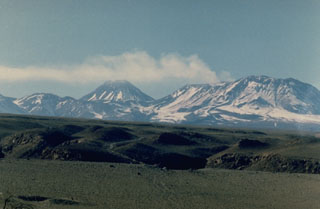Report on Lascar (Chile) — 4 October-10 October 2023
Smithsonian Institution / US Geological Survey
Weekly Volcanic Activity Report, 4 October-10 October 2023
Managing Editor: Sally Sennert.
Please cite this report as:
Global Volcanism Program, 2023. Report on Lascar (Chile) (Sennert, S, ed.). Weekly Volcanic Activity Report, 4 October-10 October 2023. Smithsonian Institution and US Geological Survey.
Lascar
Chile
23.37°S, 67.73°W; summit elev. 5592 m
All times are local (unless otherwise noted)
On 6 October SERNAGEOMIN reported that the Alert Level for Láscar had been lowered to Green (the lowest level on a four-color scale) because activity had returned to baseline levels. During 16-30 September sulfur dioxide gas emissions were low, averaging 565 tons per day (t/d) with a maximum of 1,109 t/d on 28 September. Passive, low-energy, whitish gas continued to be emitted, rising as high as 600 m above the crater rim on 28 September. Thermal anomalies continued to be absent in satellite data and deformation was not detected. The public was warned to stay at least 500 m away from the crater. SENAPRED declared a “preventative early warning” for San Pedro de Atacama (70 km NW) and maintained a safety perimeter of 3 km around the volcano.
Geological Summary. Láscar is the most active volcano of the northern Chilean Andes. The andesitic-to-dacitic stratovolcano contains six overlapping summit craters. Prominent lava flows descend its NW flanks. An older, higher stratovolcano 5 km E, Volcán Aguas Calientes, displays a well-developed summit crater and a probable Holocene lava flow near its summit (de Silva and Francis, 1991). Láscar consists of two major edifices; activity began at the eastern volcano and then shifted to the western cone. The largest eruption took place about 26,500 years ago, and following the eruption of the Tumbres scoria flow about 9000 years ago, activity shifted back to the eastern edifice, where three overlapping craters were formed. Frequent small-to-moderate explosive eruptions have been recorded since the mid-19th century, along with periodic larger eruptions that produced ashfall hundreds of kilometers away. The largest historical eruption took place in 1993, producing pyroclastic flows to 8.5 km NW of the summit and ashfall in Buenos Aires.
Sources: Servicio Nacional de Geología y Minería (SERNAGEOMIN), Sistema y Servicio Nacional de Prevención y Repuesta Ante Desastres (SENAPRED)

